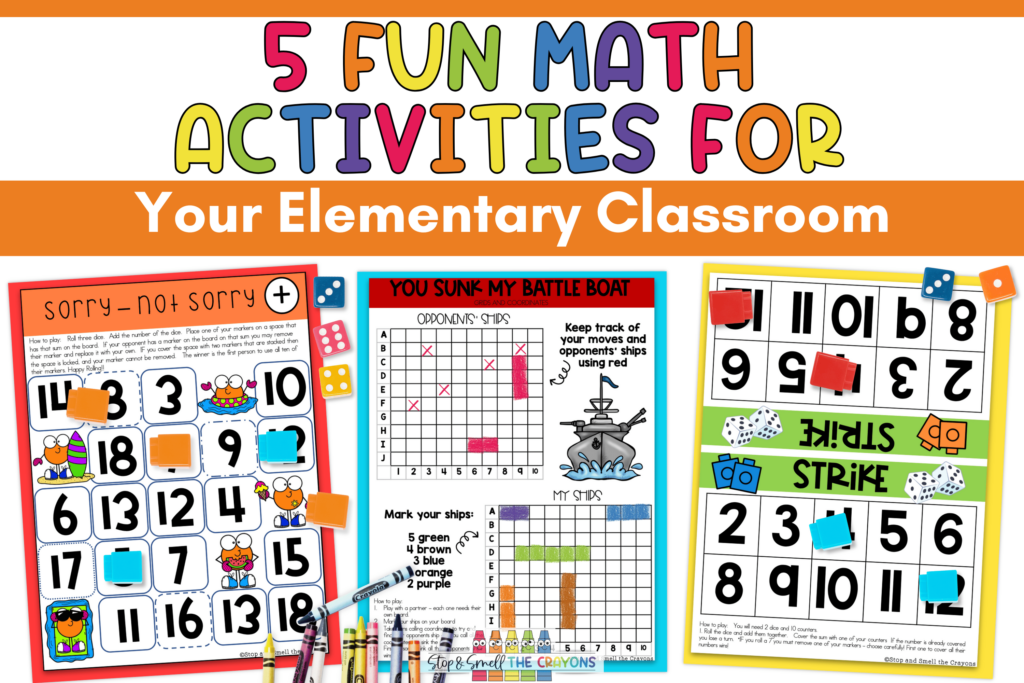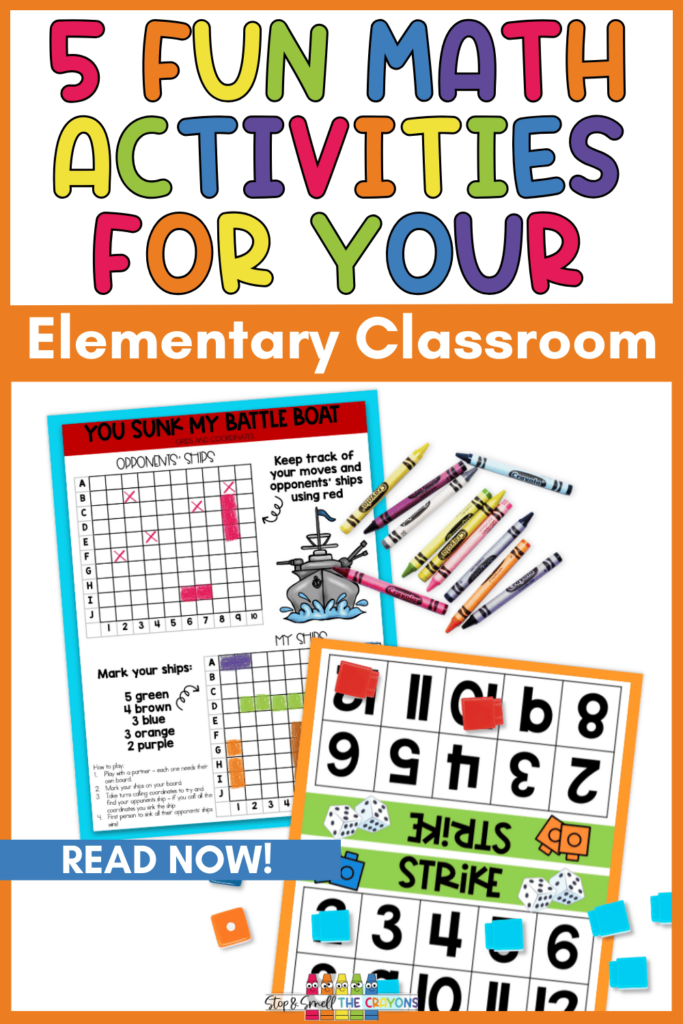I still remember the day I discovered how powerful it was to gamify math for my students. Suddenly, math practice wasn’t something they had to do. It was something they wanted to do. By turning lessons into fun math activities, I noticed my students became more willing to take risks and tackle challenges they might have avoided before. It was all because they were having fun! When math feels approachable and exciting, it opens the door for growth, confidence, and many smiles. Today, I’m sharing some of my favorite fun math activities that have transformed my classroom and made learning a blast.

Benefits of Gamifying Learning With Fun Math Activities

When I started incorporating fun math activities into my lessons, the benefits were impossible to ignore. First, my students became so much more engaged. Instead of sighs and groans, I heard laughter, excitement, and a whole lot of “Can we do that again?” Gamifying learning made math approachable and helped my kids see mistakes as part of the game instead of something to fear.
Another big win? Risk-taking. My students who were hesitant to try challenging problems suddenly felt comfortable diving in because the pressure was gone. They were focused on the fun, not just getting the right answer. This approach allowed them to problem-solve in a natural and rewarding way.
I also noticed a shift in collaboration. Whether it was a partner game, small group challenge, or class-wide activity, my students worked together to tackle problems. They shared strategies, encouraged each other, and celebrated their successes as a team. It was incredible to see those “lightbulb moments” happen through peer interaction.
Fun math activities provide a break from traditional worksheets while still reinforcing essential skills. Learning through play helps concepts stick. Our kiddos might not even realize how much they’re practicing because they’re so caught up in the activity!
Incorporating fun math activities isn’t just about making math enjoyable. It’s about transforming the learning experience. It opens up opportunities for critical thinking, teamwork, and growth while creating a classroom environment full of joy and curiosity. Let’s be honest, seeing our kiddos excited about math is a win for everyone!
Math Games to Use as Fun Math Activities
Now that we’ve talked about the benefits of gamifying math let’s dive into some of my favorite fun math activities that you can use in your classroom. These are tried and true ways to excite your students about math, build their confidence, and make learning feel like play. Let’s make math fun together!
1. Decimals for Dinner

One of my favorite fun math activities to teach adding and subtracting decimals is Decimals for Dinner. My students can’t get enough of it! This activity is a game-changer because it combines real-life scenarios with hands-on practice all centered around food. Here’s how I use it and why it’s such a hit in my classroom.
I start by handing out the “Let’s Eat” menu, recording sheets, and dice. I let my students work independently or in pairs, making my classroom setup flexible. Each player takes turns rolling the die to “build” their meal. The number rolled corresponds to specific food and drink options on the menu, from steak and pasta to pie and milkshakes. Students record the cost of each item on their recording sheet. Then, they add up their total to create a real-life “bill” for their meal.
The real fun begins once the totals are calculated—enter the Tragedy Strikes sheet. Students roll the die again to find out what unexpected event happens to their bill. Maybe their waitress dropped a drink (subtract the cost), or they found a coupon (hooray for discounts!). This twist makes my kids think critically as they recalculate their totals. They repeat the process for four meals, which gives them plenty of practice with decimals while keeping them engaged.
My students absolutely light up during this activity because it feels like a game rather than a math lesson. They’re so busy rolling dice, building meals, and laughing at the “tragedies” that they don’t even realize how much math they’re practicing. I’ve found that this activity builds confidence because the real-world application of decimals makes the skill more approachable.
2. Battle Boats Grids and Coordinates

When it comes to teaching grids and coordinates, Battle Boats is one of my go-to fun math activities. Not only does it make practicing this skill feel like a game, but it also encourages strategic thinking and friendly competition among my students. It’s a classroom-friendly spin on the classic Battleship game, and my kids love it!
I pair my students up and hand out their Battle Boats boards. Each player gets their own grid. They secretly mark the positions of their ships using the colors specified in the resource—5 green spaces, 4 brown, 3 blue, 3 orange, and 2 purple. I always emphasize the importance of strategy here. How they place their ships will determine their success!
Once the ships are placed, the game begins. Players take turns calling out coordinate pairs, like “B-5” or “H-2,” trying to guess the location of their partner’s ships. If a coordinate hits part of a ship, their opponent has to confirm it. I have students keep track of their moves and hits using red markers on the grid. The game continues until one player successfully sinks all of their opponent’s ships.
My students are always excited when it’s Battle Boats day because they get to play while practicing an important math skill. It doesn’t feel like work, but they’re constantly using coordinate pairs, thinking ahead, and adjusting their strategies as the game unfolds. I’ve also seen my kids, who typically shy away from math, feel more confident and engaged with this activity because it’s hands-on and fun.
Battle Boats is one of those fun math activities that sneaks in skill practice without our students even realizing it. By the end of the game, they’ve mastered grids and coordinates, improved their critical thinking, and had a great time doing it.
3. Capture the Square

Capture the Square is a classroom favorite that checks all the boxes if you’re looking for fun math activities to reinforce multiplication skills. It’s engaging, competitive, and packed with skill-building opportunities! My students love it, and it quickly became one of those activities that I can always count on to make math feel exciting.
I introduce Capture the Square as a partner or small group game. Each group gets a printed game board filled with multiplication facts. Then, I have my students take turns solving the problems and “capturing” the squares by marking them with their chosen color or symbol (a dot, X, or any marker works). The goal? Capture as many squares as possible by answering correctly.
What keeps my kiddos hooked is the competitive nature of the game. They strategize to grab squares and block their opponents, all while solving multiplication facts. The game ends when all squares have been claimed. The player with the most squares captured wins the game. This setup gives my kids plenty of opportunities to practice multiplication in a way that feels like a challenge rather than a chore.
Capture the Square has quickly become a classroom hit because it combines learning and fun seamlessly. My kiddos are so focused on capturing the most squares that they forget they’re practicing multiplication. I see a huge boost in their confidence with facts they’ve struggled with before simply because they’re solving problems repeatedly in a game setting.
4. Strike

Strike is one of those fun math activities combining simple rules, a touch of strategy, and a lot of excitement. My students love it because it feels like a fast-paced game. Behind all the fun, they’re getting essential addition practice without even realizing it.
To set up, I give each pair of students two dice, ten counters, and a Strike game board. The rules are straightforward, which makes it perfect for centers, early finishers, or small group work. Students take turns rolling two dice, adding the numbers together, and covering the corresponding sum on their game board with a counter.
Here’s the twist. Rolling a seven means trouble! If a player rolls a 7, they have to remove one of their counters from the board. This always adds a little suspense and drama to the game. The goal is to be the first player to cover all their numbers. With the possibility of losing progress, the game stays exciting right until the very end.
The thrill of racing to cover all their numbers while avoiding the dreaded “7” is what hooks my students. They’re fully engaged, cheering when they roll the right sum and groaning dramatically when they lose a counter. Either way, they’re practicing their addition facts over and over again, building fluency without even realizing it.
5. Sorry Not Sorry

When I’m looking for fun math activities to help my students practice addition while keeping their energy high, Sorry Not Sorry is at the top of my list. It’s a perfect mix of skill-building, strategy, and friendly competition that excites everyone about math.
I hand out a Sorry Not Sorry game board, three dice, and ten markers to each pair or small group of students. The game starts with players taking turns rolling all three dice and adding up the numbers. Once they find the sum, they place one of their markers on the corresponding space on the board.
Here’s where things get interesting. If a player rolls a sum already with their opponent’s marker, they can say, “Sorry!” and replace their marker with their own. This adds just the right amount of excitement and keeps everyone on their toes! However, if a player manages to stack two of their own markers in the same space, it becomes “locked,” meaning no one can remove it.
The first player to use all ten of their markers wins the game. Let me tell you, my students love the mix of strategy, risk, and the satisfaction of saying, “Sorry, not Sorry!” as they reclaim spaces on the board.
My students enjoy this activity because it feels like a game, not work. They cheer when they roll just the right number to bump a classmate’s marker. They strategize to lock in spaces as fast as possible. Plus, they’re getting non-stop addition practice without realizing how much learning they’re doing.
Additional Resources
If you’re loving these fun math activities as much as my students do, I’ve got even more ideas to keep the excitement going! These activities are perfect for reinforcing skills, keeping kids engaged, and making math time something they look forward to. Check out the resources below for even more ways to bring hands-on learning and fun into your classroom!
Make Math Exciting With Fun Math Activities
Incorporating fun math activities into your classroom can completely transform how students feel about math. By turning practice into play, we give our kiddos the opportunity to build confidence, strengthen their skills, and enjoy learning along the way. These activities show our students that math doesn’t have to be intimidating. It can be engaging, exciting, and even their favorite part of the day. So, if you’re ready to make math time something your students can’t wait for, start with these ideas!
Save for Later
Remember to save this post to your favorite math Pinterest board for quick access to these fun math activities!
